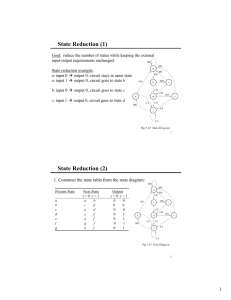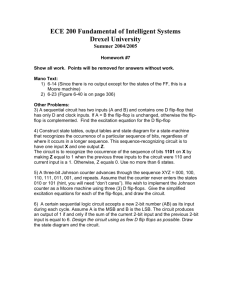Synchronous Sequential Logic
advertisement
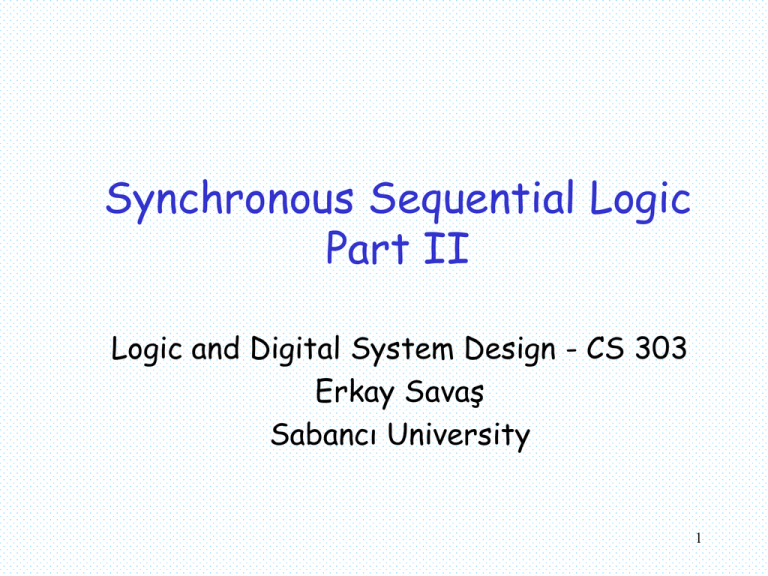
Synchronous Sequential Logic Part II Logic and Digital System Design - CS 303 Erkay Savaş Sabancı University 1 State Reduction and Assignment • In the design process of sequential circuits certain techniques are useful in reducing the circuit complexity – state reduction – state assignment • State reduction – Fewer states fewer number of flip-flops – m flip-flops 2m states – Example: m = 5 2m = 32 • If we reduce the number of states to 21 do we reduce the number of flip-flops? 2 Example: State Reduction 0/0 a 0/0 1/0 0/0 0/0 b 1/0 1/1 g 0/0 1/0 0/0 d 1/1 0/0 c Note that we use letters to designate the states for the time being e 1/1 f 1/1 3 Example: State Reduction state a a b c f g f f g a a input 0 1 0 1 0 1 1 0 0 0 0 output 0 0 0 0 0 1 1 0 0 0 • What is important – not the states – but the output values the circuit generates • Therefore, the problem is to find a circuit – with fewer number of states, – but that produces the same output pattern for any given input pattern, starting with the same initial state 4 State Reduction Technique 1/7 0/0 a 1/0 • Step 1: get a state table present state b next state Output x=0 x=1 x=0 x=1 a a b 0 0 b c d 0 0 c c f 0 0 d e f 0 1 e a f 0 1 f g f 0 1 g a f 0 1 5 State Reduction Technique 2/7 • Step 2: Inspect the state table for equivalent states – – Equivalent states: Two states, 1. that produce exactly the same output 2. whose next states are identical for each input combination 6 State Reduction Technique 3/7 present state next state Output x=0 x=1 x=0 x=1 a a b 0 0 b c d 0 0 c c f 0 0 d e f 0 1 e a f 0 1 f g f 0 1 g a f 0 1 • States “e” and “g” are equivalent • One of them can be removed 7 State Reduction Technique 4/7 present state next state Output x=0 x=1 x=0 x=1 a a b 0 0 b c d 0 0 c c f 0 0 d e f 0 1 e a f 0 1 f e f 0 1 • We keep looking for equivalent states 8 State Reduction Technique 5/7 present state next state Output x=0 x=1 x=0 x=1 a a b 0 0 b c d 0 0 c c d 0 0 d e d 0 1 e a d 0 1 • We keep looking for equivalent states 9 State Reduction Technique 6/7 present state next state Output x=0 x=1 x=0 x=1 a a b 0 0 b b d 0 0 d e d 0 1 e a d 0 1 • We stop when there are no equivalent states 10 State Reduction Technique 7/7 0/0 present state a 1/0 0/0 0/0 0/0 next state Output x=0 x=1 x=0 x=1 a a b 0 0 b b d 0 0 d e d 0 1 e a d 0 1 b 1/0 1/0 d 1/1 0/0 e We need two flip-flops 1/1 state a a b b d e d d e a a input 0 1 0 1 0 1 1 0 0 0 0 output 0 0 0 0 0 1 1 0 0 0 11 State Assignments 1/4 • We have to assign binary values to each state • If we have m states, then we need a code with minimum n bits, where n = log2m • There are different ways of encoding • Example: Eight states: S0, S1, S2, S3, S4, S5 , S6 , S7 State Binary Gray One-hot S0 000 000 000001 S1 001 001 000010 S2 010 011 000100 S3 011 010 001000 S4 100 110 010000 S5 101 111 100000 S6 111 101 100000 S7 111 100 100000 12 State Assignments 2/4 • The circuit complexity depends on the state encoding (assignment) scheme • Previous example: binary state encoding present state next state Output x=0 x=1 x=0 x=1 (a) 00 00 01 0 0 (b) 01 01 10 0 0 (d) 10 11 10 0 1 (e) 11 00 10 0 1 13 State Assignments 3/4 0/0 a 1/0 • Gray encoding 0/0 0/0 b 0/0 1/0 d 1/0 0/0 e 1/1 present state next state Output x=0 x=1 x=0 x=1 (a) 00 00 01 0 0 (b) 01 01 11 0 0 (d) 11 10 11 0 1 (e) 10 00 11 0 1 14 State Assignments 4/4 • One-hot encoding present state next state Output x=0 x=1 x=0 x=1 (a) 0001 0001 0010 0 0 (b) 0010 0010 0100 0 0 (d) 0100 1000 0100 0 1 (e) 1000 0001 0100 0 1 15 Designing Sequential Circuits • Combinational circuits – can be designed given a truth table • Sequential circuits – We need, • state diagram or • state table – Two parts • flip-flops: number of flip-flops is determined by the number of states • combinational part: – output equations – flip-flop input equations 16 Design Process • Once we know the types and number of flipflops, design process is reduced to design process of combinational circuits • Therefore, we can apply the techniques of combinational circuit design • The design steps 1. Given a verbal description of desired operation, derive state diagram 2. Reduce the number of states if necessary and possible 3. State assignment 17 Design Steps (cont.) 4. 5. 6. 7. • Obtain the encoded state table Derive the simplified flip-flop input equations Derive the simplified output equations Draw the logic diagram Example: Verbal description – – – “we want a (sequential) circuit that detects three or more consecutive 1’s in a string of bits” Input: string of bits of any length Output: • “1” if the circuit detects the pattern in the string • “0” otherwise 18 Example: State Diagram • Step 1: Derive the state diagram 0 1 S0 /0 S1/0 0 0 0 S3/1 1 1 Moore Machine S2/0 1 19 Synthesis with D Flip-Flops 1/5 • The number of flip-flops – Four states 0 – ? flip-flops • State reduction 1 S0 /0 – not possible in this case • State Assignment 0 0 0 – Use binary encoding • S0 00 • S1 01 S1/0 S3/1 1 1 S2/0 1 • S2 10 • S3 11 20 Synthesis with D Flip-Flops 2/5 • Step 4: Obtain the state table 0 Present state Input A B x 0 0 0 0 0 1 0 1 0 0 1 1 1 0 0 1 0 1 1 1 0 1 1 1 Next state A B Output 1 S0 /0 y S1/0 0 0 1 0 S3/1 S2/0 1 1 21 Synthesis with D Flip-Flops 3/5 • Step 5: Choose the flip-flops – D flip-flops • Step 6: Derive the simplified flip-flop input equations – Boolean expressions for DA and DB Present state Input Next state Output A B x A B y 0 0 0 0 0 0 0 0 1 0 1 0 0 1 0 0 0 0 0 1 1 1 0 0 1 0 0 0 0 0 1 0 1 1 1 0 1 1 0 0 0 1 1 1 1 1 1 1 Bx A 0 1 00 01 11 10 0 0 0 1 1 1 0 0 DA = Ax + Bx 22 Synthesis with D Flip-Flops 3/5 Present state Input Next state Bx Output A B x A B y 0 0 0 0 0 0 0 0 1 0 1 0 0 1 0 0 0 0 0 1 1 1 0 0 1 0 0 0 0 0 1 0 1 1 1 0 1 1 0 0 0 1 1 1 1 1 1 1 A • Step 7: Derive the simplified output equations – Boolean expressions for y. 0 1 00 01 11 10 0 0 1 1 0 1 0 0 DB = Ax + B’x Bx A 0 1 00 01 11 10 0 0 0 0 0 1 0 1 y = AB 23 Synthesis with D Flip-Flops 5/5 • Step 8: Draw the logic diagram DA = Ax + Bx y = AB DB = Ax + B’x x DA Q D C A R y DB Q D C clock reset B R 24 Synthesis with T Flip-Flops 1/4 • Example: 3-bit binary counter with T flip-flops – 012 ... 7 0 1 2 How many flip-flops? S0 S1 S7 S2 S6 S3 S5 State assignments: • S0 000 • S1 001 • S2 010 • ... • S7 111 S4 State Diagram 25 Synthesis with T Flip-Flops 2/4 • State Table present state A2 A1 A0 0 0 0 0 0 1 0 1 0 0 1 1 1 0 0 1 0 1 1 1 0 1 1 1 next state A2 A1 A0 0 0 1 0 1 0 0 1 1 1 0 0 1 0 1 1 1 0 1 1 1 0 0 0 FF inputs T2 T1 T0 26 Synthesis with T Flip-Flops 3/4 Present state A2 A1 A0 T2 T1 T0 0 0 0 0 0 1 0 0 1 0 1 1 0 1 0 0 0 1 0 1 1 1 1 1 1 0 0 0 0 1 1 0 1 0 1 1 1 1 0 0 0 1 1 1 1 1 1 1 A1 A0 A2 0 1 • Flip-Flop input equations FF inputs A1 A0 A2 0 1 01 11 10 0 0 0 0 1 1 0 0 T2 = A1A0 00 01 11 10 0 0 1 1 1 1 0 0 T1 = A0 00 T0 = 1 27 Synthesis with T Flip-Flops 4/4 • Circuit logic-1 T0 C T2 = A1A0 T1 = A0 T0 = 1 Q T T1 T2 clock reset R Q T C A1 R Q T C A0 A2 R 28 Synthesis with JK Flip-Flops 1/4 Q(t+1) = JQ’ + K’Q • State Table & JK FF Inputs Present state Input next state J K Q(t+1) 0 0 Q 0 1 0 1 0 1 1 1 Q’ Flip-flop inputs A B x A B JA KA JB KB 0 0 0 0 0 0 X 0 X 0 0 1 0 1 0 X 1 X 0 1 0 1 0 1 X X 1 0 1 1 0 1 0 X X 0 1 0 0 1 0 X 0 0 X 1 0 1 1 1 X 0 1 X 1 1 0 1 1 X 0 X 0 1 1 1 0 0 X 1 X 29 1 Synthesis with JK Flip-Flops 2/4 • Optimize the flip-flop input equations Flip-flop inputs A B x A(t+1) 0 0 0 0 0 0 1 0 1 0 B(t+1) JA KA JB KB 0 0 X 0 X 0 1 0 X 1 X 0 1 0 1 X X 1 1 1 0 1 0 X X 0 1 0 0 1 0 X 0 0 X 1 0 1 1 1 X 0 1 X 1 1 0 1 1 X 0 X 0 1 1 1 0 0 X 1 X 1 Bx A 0 1 00 01 11 10 0 X 0 X 0 X 1 X JA = Bx’ Bx A 00 01 11 10 0 0 1 X X 1 0 1 X X JB = x Synthesis with JK Flip-Flops 3/4 Flip-flop inputs A B x A(t+1) 0 0 0 0 0 0 1 0 1 0 B(t+1) JA KA JB KB 0 0 X 0 X 0 1 0 X 1 X 0 1 0 1 X X 1 1 1 0 1 0 X X 0 1 0 0 1 0 X 0 0 X 1 0 1 1 1 X 0 1 X 1 1 0 1 1 X 0 X 0 1 1 1 0 0 X 1 X 1 Bx A 0 1 Bx 00 01 11 10 X 0 X 0 X 1 X 0 KA = Bx A 0 1 00 01 11 10 X X X X 0 1 1 0 KB = (A x)’ 31 Synthesis with JK Flip-Flops 4/4 • Logic diagram JA = Bx’ KA = Bx JB = x KB = (A x)’ J x Q A Q B C K J D clk K C C 32 Unused States S0 Modulo-5 counter S1 S4 S2 S3 Present State Next State A B C A B C 0 0 0 0 0 1 0 0 1 0 1 0 0 1 0 0 1 1 0 1 1 1 0 0 1 0 0 0 0 0 33 Example: Unused States 1/4 Present State Next State A B C A B C 0 0 0 0 0 1 0 0 1 0 1 0 0 1 0 0 1 1 0 1 1 1 0 0 1 0 0 0 0 0 A 00 01 11 10 0 1 A(t+1) = BC BC A BC 00 01 11 10 A 00 0 0 1 1 B(t+1) = 01 11 10 C(t+1) = 34 Example: Unused States 2/4 Present State Next State A B C A B C 0 0 0 0 0 1 0 0 1 0 1 0 0 1 0 0 1 1 0 1 1 1 0 0 1 0 0 0 0 0 1 1 0 0 1 0 1 1 1 1 0 0 A(t+1) = BC B(t+1) = B C C(t+1) = A’C’ 111 000 001 100 010 011 101 110 35 Example: Unused States 3/4 • Not using don’t care conditions Present State BC Next State A B C A B C 0 0 0 0 0 1 0 0 1 0 1 0 0 1 0 0 1 1 0 1 1 1 0 0 1 0 0 0 0 0 00 01 11 10 0 0 0 1 0 1 0 0 0 0 A(t+1) = A’BC BC BC A A 00 01 11 10 0 0 1 0 1 1 0 0 0 0 B(t+1) = A’B’C + A’BC’ = A’(B C) A 00 01 11 10 0 1 0 0 1 1 0 0 0 0 C(t+1) = A’C’ 36 Example: Unused States 4/4 Present State Next State A B C A B C 0 0 0 0 0 1 0 0 1 0 1 0 0 1 0 0 1 1 0 1 1 1 0 0 1 0 0 0 0 0 101 110 111 000 001 100 010 011 A(t+1) = A’BC B(t+1) = A’(B C) C(t+1) = A’C’ 37 Sequential Circuit Timing 1/3 • It is important to analyze the timing behavior of a sequential circuit – Ultimate goal is to determine the maximum clock frequency clk ts th D Q tp, FF 38 Sequential Circuit Timing 2/3 tp clk tp,FF ts tp,COMB Combinational Circuit inputs tp = tp,FF + tp,COMB + ts outputs tp,COMB current state Flip-flops Q clock C tp,FF D ts Flip-flop inputs 39 Sequential Circuit Timing 2/3 tp clk tp,FF ts tp,COMB Combinational Circuit inputs tp,FF + tp,COMB >> th outputs tp,COMB current state Flip-flops Q clock C tp,FF D Flip-flop inputs 40 Sequential Circuit Timing 3/3 • Minimum clock period (or maximum clock frequency) tp clk tp,FF tp,COMB ts tp clk tp,FF tp,COMB ts 41 Example: Sequential Circuit Timing A D B Q C B’ clk y x tp,NOT = 0.5 ns tp,XOR = 2.0 ns tp,FF = 2.0 ns tp,AND = ts = 1.0 ns th = 0.25 ns Find the longest path delay from external input to the output tp,XOR + tp,XOR = 2.0 + 2.0 = 4.0 ns 42 Example: Sequential Circuit Timing A D B Q C B’ clk y x tp,NOT = 0.5 ns tp,XOR = 2.0 ns tp,FF = 2.0 ns tp,AND = ts = 1.0 ns th = 0.25 ns Find the longest path delay in the circuit from external input to positive clock edge tp,XOR + tp,NOT = 2.0 + 0.5 = 2.5 ns 43 Example: Sequential Circuit Timing A D B Q C B’ clk y x tp,NOT = 0.5 ns tp,XOR = 2.0 ns tp,FF = 2.0 ns tp,AND = ts = 1.0 ns th = 0.25 ns Find the longest path delay from positive clock edge to output tp,FF + tp,XOR = 2.0 + 2.0 = 4.0 ns 44 Example: Sequential Circuit Timing A D B Q C B’ clk y x tp,NOT = 0.5 ns tp,XOR = 2.0 ns tp,FF = 2.0 ns tp,AND = ts = 1.0 ns th = 0.25 ns Find the longest path delay from positive clock edge to the flip-flop input tp,FF + tp,AND + tp,XOR + tp,NOT = 2.0 + 1.0 + 2.0 + 0.5 = 5.5 ns 45 Example: Sequential Circuit Timing A D B Q C B’ clk y x tp,NOT = 0.5 ns tp,XOR = 2.0 ns tp,FF = 2.0 ns tp,AND = ts = 1.0 ns th = 0.25 ns Determine the maximum frequency of operation of the circuit in megahertz tp = tp,FF + tp,AND + tp,XOR + tp,NOT + ? = 2.0 + 1.0 + 2.0 + 0.5 + 1.0 = 6.5 ns fmax = 1/tp = 1/(6.5×10-9) 154 MHz 46 Example Binary encoding S0 S1 S3 D x1 Q C S2 tp,XOR = 2.0 ns tp,FF = 2.0 ns D x0 Q C x0’ ts = 1.0 ns tp = tp,FF + tp,XOR + ts = 2.0 + 2.0 + 1.0 = 5.0 ns fmax = 1/tp = 1/(5.0×10-9) 200 MHz 47 Example: One-Hot-Encoding S0 S1 S2 S3 0001 0010 0100 1000 tp,FF = 2.0 ns D C Q y0 D Q y1 Q y2 Q y3 ts = 1.0 ns tp = tp,FF + ts = 2.0 + 1.0 = 3.0 ns D C C fmax = 1/tp = 1/(3.0×10-9) 333 MHz D C 48



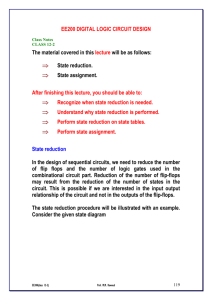
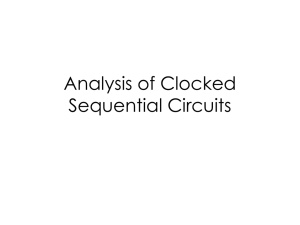
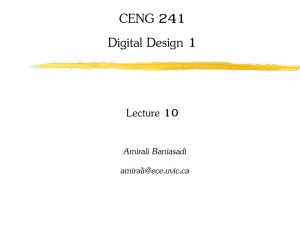
![Sequential Circuits-Radha Iyer[cs 151]](http://s3.studylib.net/store/data/009253826_1-9ea30ee9b3f2c51b0308a42ccf258b21-300x300.png)
